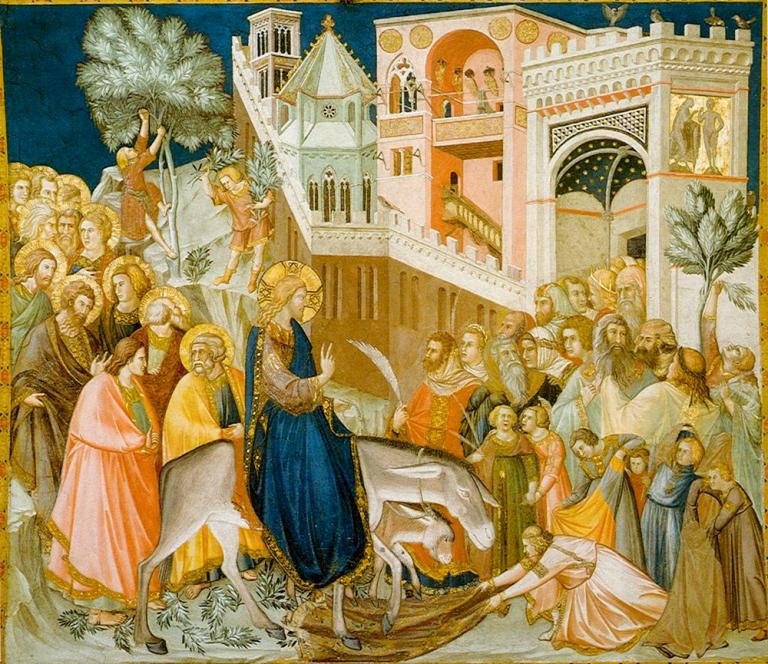This coming weekend we celebrate Palm Sunday, the dramatic events that mark the beginning of Holy Week. In this blog I will talk about some of the Old Testament passages that very strongly parallel the account as we read it in the gospels, and ask just what those linkages and foreshadowings actually mean. I will also talk about what I believe is the perfect scriptural text for reading and re-reading during the Easter season.
Psalms, Messianic and Prophetic
Any acquaintance with the gospels shows the very close and frequent parallels with a fairly tight range of Old Testament passages. As I noted recently, the narrative of Palm Sunday strongly recalls the latter chapters of Zechariah,with its account of a king entering the city “lowly, and riding upon an ass, and upon a colt the foal of an ass.” Even so, by far the closest linkages are with a select group of Psalms. This is not surprising, in that Jews of this era knew the Psalms very well from regular worship, and a few in particular had come to be regarded as strongly prophetic and messianic.
When we hear early Christian preaching and polemic as it is reflected in Acts, we very often hear texts like the opening verses of Psalm 110, which is quoted or echoed in all the Synoptics, in Hebrews, Colossians, 1 Corinthians, and 1 Peter. Psalms 2, 69, and 91 were very popular, as were at least particular verses of Psalms 16 and 34. I won’t go into detail in this short post, but you can find much more information at any number of sites concerned with “Messianic Psalms,” or “Messianic Prophecies In The Psalms.” (That last one is quite full). Psalm 22 had an overwhelming impact because it seems to offer a scrupulously detailed portrait of the crucifixion, right down to the vision of Jesus’s captors dicing for his clothing, as described in Psalm 22.18. If you were an early Jesus follower, you had an arsenal of eight or so select psalms ever close to hand, ready for instant rhetorical deployment, whether against potential converts, skeptics, or persecutors.
Some of those psalm texts seem to align very closely with the events of Jesus’s life, and especially his last days (as in Psalm 22), and just how we interpret those passages is open to debate. If you are a Biblical literalist, then those Old Testament passages were authentic prophetic visions of the fate of Christ, who claimed the inheritance of that King David who reputedly was the author of those same Psalms. That prophetic view would still hold even if, like most academic scholars of Psalms, you reject the Davidic authorship. From that perspective, what happened to Jesus literally and specifically fulfilled ancient prophecies.
But with all respect to believers who accept that approach, alternative views are possible. One is that Jesus and his circle imitated or re-enacted those older passages, as a kind of assertion of messianic claims. In the case of Palm Sunday, they were chiefly following Zechariah.
Or else, perhaps Jesus’s circle consciously wrote their narratives in light of those older texts, and adapted their accounts of events to fit what they read. In that sense, they would be retroactive prophecies, written after Jesus’s death, and maybe decades later. As probably the clearest example of this retroactive rewriting, John Dominic Crossan cited the story of casting lots for Jesus’s clothing, and said that if the reader was not prepared to accept this, they would not accept anything short of a full-fledged prophetic interpretation. That may be my muddled recollection of Crossan’s exact words, but it’s close, and his point is well taken.
THE Psalm For Holy Week
With all that in mind, I would like to look at one particular psalm, namely 118, which is by no means the best known today, but it has a really significant history, and it lay at the core of that select group of scriptures that the earliest Christians lived and breathed. This psalm, the Confitemini Domino, almost certainly originated in the liturgy for the Jerusalem Temple, where it was used for the procession leading in at Passover. In the Christian context, it dominates Mark’s two critical chapters 11 and 12, which concern Jesus’s entry into Jerusalem, and the corresponding passages in Matthew and Luke. I would argue that these texts using 118 are strong candidates to have been retroactive prophecies.
Here is the context. Jesus enters the city and arrives at the Temple, where he preaches an incendiary sermon about the wicked tenants who rent a vineyard, but who refuse to pay the rent or to respect the landowner. They drive off the landlord’s messengers, wounding or killing them, until finally they kill his son. And then, in the words of the King James version
What shall therefore the lord of the vineyard do? he will come and destroy the husbandmen, and will give the vineyard unto others. And have ye not read this scripture; The stone which the builders rejected is become the head of the corner (OR the cornerstone, κεφαλὴν γωνίας).
Temple authorities are appalled, as they instantly recognize the story’s meaning: God is the landowner, and the clerical authorities have repeatedly scorned and persecuted his messengers, the prophets, so that they now face a terminal judgment. According to Mark, this sets the stage for the authorities’ determination to capture and remove Jesus. It is the main detonator of what follows. Incidentally, Jesus then goes on to quote that ever-popular Psalm 110, which I have already mentioned as a key messianic text.
The story of the wicked tenants has to be read in light of the events of the Jewish revolt and the fall of Jerusalem in 70 AD, when “the vineyard” actually was given to others, from Jews to Gentile conquerors. As such, the story must either be a prophetic forecast of events yet to come, of Jesus’s death, and of the subsequent wars, or else it is a retroactive prophecy, presumably dating from in or shortly after the year 70. I believe the latter, and I base that not just on my own prejudices, but on another inextricably linked element in that story.
Look at that quote about “The stone which the builders rejected,” which is from Psalm 118, and was also very popular with Jesus’s earliest followers: it appears in Acts, Ephesians, and 1 Peter. But what does it mean, and why was it applicable here? It was multiply appealing, because the Hebrew original offered a useful pun that paralleled stone (‘eben) with son (ben). But it also made wonderful sense in terms of the death of Jesus, which occurred at Golgotha, or Calvary. And before it was famous as a site for public execution, that place had quite a different function, as a quarry. You know, the sort of place where people where very familiar with stones of different quality, which they selected or rejected according to their particular needs and tastes. Some are rejects, some are excellent enough to head the corner. In the context of a city in the middle of a colossal multi-decade building project, the nature and quality of stones must have been a very familiar subject of discussion and debate, no less than their sources.
After the Event
I suggest it was only after the crucifixion – that execution in a quarry – that Jesus’s followers found such extraordinary relevance and value in that verse of Psalm 118, which they naturally linked to the circumstances of his death, and its location. Once they had done that, the whole Psalm could be read as an assertion of victory, of triumph, and of Resurrection. Here is that “cornerstone” verse in context (17-24, KJV):
I shall not die, but live, and declare the works of the Lord.
The Lord hath chastened me sore: but he hath not given me over unto death.
Open to me the gates of righteousness: I will go into them, and I will praise the Lord:
This gate of the Lord, into which the righteous shall enter.
I will praise thee: for thou hast heard me, and art become my salvation.
The stone which the builders refused is become the head stone of the corner.
This is the Lord‘s doing; it is marvelous in our eyes.
This is the day which the Lord hath made; we will rejoice and be glad in it.
Did early believers ever go to the site of Christ’s tomb and recite those verses?
Making Palm Sunday
But there is even more to Psalm 118, which those early Christians also knew very well. I have already quoted Mark’s 12th chapter, but look at the preceding chapter, where we read about Jesus’s royal entry into the city, and the Temple. As Jesus enters, the crowd welcome him:
And many spread their garments in the way: and others cut down branches off the trees, and strawed them in the way. And they that went before, and they that followed, cried, saying, Hosanna; Blessed is he that cometh in the name of the Lord: Blessed be the kingdom of our father David, that cometh in the name of the Lord: Hosanna in the highest.
Put another way, what the crowd does is to re-enact the latter verses of Psalm 118, and pretty exactly. Here is the NIV rendering:
Lord, save us! Lord, grant us success!
Blessed is he who comes in the name of the Lord.
From the house of the Lord we bless you.
The Lord is God,
and he has made his light shine on us.
With boughs in hand, join in the festal procession
up to the horns of the altar.
That “Save us” is the Hebrew Hosanna, and the words used in the Greek Septuagint (v.25) are
ὦ Κύριε, σῶσον δή O Kyrie, soson de! O Lord, save now!
The “Blessed is he” verse in 118 is taken over directly by the Christian gospels. Those same gospels tell of the crowd bearing boughs for the procession to the Temple.
So we face those same questions again. The Palm Sunday narrative looks very much indeed like what we find in Psalm 118. So was that Psalm a miraculous inspired prophecy? Or did early believers literally enact the events with the intention of fulfilling a scriptural prophecy? Or did the early evangelists tailor their accounts to mesh with the scriptures they so cherished?
After reporting the Palm Sunday entry into Jerusalem, and the scriptural references from Zechariah and 118, John’s gospel explicitly states that “At first his disciples did not understand all this. Only after Jesus was glorified did they realize that these things had been written about him and that these things had been done to him” (12.16). In other words, only in retrospect did they construct the story’s true meaning, and its relation to scripture.
Whatever you think about those specific questions, I offer that powerful Psalm 118 as ideal reading for the coming week, and through the Easter season. You will hear it echoed everywhere.
The literature on Psalms is vast, but a wonderful place to begin is always Susan Gillingham, Psalms Through the Centuries, 3 vols (Chichester: Wiley-Blackwell, 2012–2022). For Psalm 118, see her vol. iii, 231-240.














